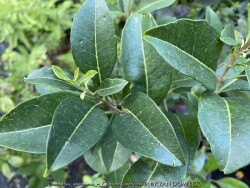

Devilwood (Osmanthus americanus / Cartrema americana) has very hard and dense wood, hence the name. It is a slow-growing evergreen shrub or small tree native to southeastern North America and Mexico. Bright green simple leaves emerge in spring turning deeper green in summer. Cream white flowers borne on separate trees and female trees produce abundant blue/black fruit. Growth habit is somewhat open so don't count on it to provide screening or density. Grows in sun or shade but in the northern part of its range, growth is too slow and sparse in the shade. Devilwood grows in most soils including moist ones and occasional flooding. This making it an ideal rain garden plant. Becoming more drought tolerant when established, our 40 inches of typical rainfall in Eastern Kansas is sufficient if planted in good soils. The cold hardiness is surprising: as a zone 5, this could be one of the most cold-tolerant broadleaf evergreens trees available! It survived -16 degrees F and a week of single digit highs in February, 2021 with no damage. It even maintains bright green foliage in winter opposed to a dingy brownish-green like some evergreens. Useful in the garden as a background evergreen shrub or small tree. Sold as Osmanthus americanus, Cartrema americana is technically it's new botanical name.
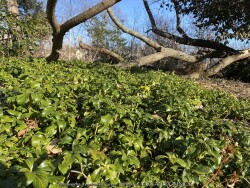

***Description for this perennial available with future update!***Green Sheen Japanese Pachysandra, is also known as Pachysandra terminalis 'Green Sheen'
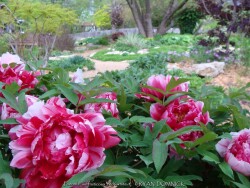

Tree Peonies (Paeonia suffruiticosa) are larger, woody relatives of the common herbaceous (perennial) peony. It does not die to the ground each winter, instead growing up to 3-5 feet after many years. Tree peonies have been in culture in China for millennia. Most "tree" peonies are really just shrubs and are grafted to the rootstock of herbaceous peonies. Peonies, along with roses are one of the most universally well-known flowers. The toughness and durability of this plant can be seen in cemeteries or around abandoned houses, surviving decades even 100 years or more without care. Both tree and herbaceous peonies are native to China in cold continental climate areas but also do well in Kansas. Large flowers come in different shades of white, red, and pink. Blooming only lasts about 3-7 days and can be short-lived if a thunderstorm happens during the second day of blooming when petals are fully open. The foliage is especially attractive in spring when unfurling into a flat, rich green and remains attractive throughout summer. Usually, by early fall, foliage is tattered from drought stress and diseases with no appreciable fall color. This has no ill effect on the health of the plant as it is already set its growth buds for next year. In northern areas (USDA zones 3-6), Peony foliage lasts all summer and turns brilliant red and orange colors in the fall. Due to its need for cold winters, peonies will not grow well further south than zone 8b. Due to its cold tolerance, peonies may be grown in above-ground pots or raised planters year-round. Ultra cold-hardy plants from northern climates normally dislike our long hot humid summers; although we are on the Southern edge of this plant's adaptability, it still survives reasonably well here. Several have been alive for over 15 years and bloom like clockwork each spring here in our Lawrence, KS display garden.


Russian sage (Perovskia atriplicifolia) is a perfectly well-adapted plant from Afghanistan, Pakistan, and Central Asia. It is the perfect match to hot Kansas summers, cold winters, rocky alkaline soils, and drought. Fine-textured foliage is upright and shrub-like consisting of a mint green to blush green color. Lavender to bluish flowers emerging in mid-summer are extremely long-lasting. In fall, Russian sage foliage dies back with the first hard freeze and becomes a whitish-gray color adding awesome winter interest. Imagine this combined with ornamental grasses or bright winter-colored plants like Color Guard Yucca. The only maintenance is cutting the plant back to you about 6 to 8 inches in the spring. New buds emerge from the root system and lower parts of the woody growth. New cultivars of Russian sage do not spread by rhizomes like the species. Russian sage thrives in dry well-drained soils with plenty of full sun and air circulation. They are suitable for hot west or south exposures, berms, parking lot islands, hell strips along roads, and other inhospitable locations. They tolerate poor soil including rock, sand, clay, and alkalinity. They do not tolerate poor drainage and will be floppy even in part shade. Russian sage flowers are highly attractive to honeybees. There are several improved cultivars with improved blooming, improved growth habit, and elimination of spreading. Blue Jean Baby Russian Sage (Perovskia atriplicifolia 'Blue Jean Baby') is a wonderful compact, non-spreading, and non-flopping variety. Lavender blue flowers held in smoky purple calyxes bloom for a long period starting in midsummer, with the color from the calyxes extending appeal into fall. Blue Jean Baby a Walters Gardens Inc. introduction.


Russian sage (Perovskia atriplicifolia) is a perfectly well-adapted plant from Afghanistan, Pakistan, and Central Asia. It is the perfect match to hot Kansas summers, cold winters, rocky alkaline soils, and drought. Fine-textured foliage is upright and shrub-like consisting of a mint green to blush green color. Lavender to bluish flowers emerging in mid-summer are extremely long-lasting. In fall, Russian sage foliage dies back with the first hard freeze and becomes a whitish-gray color adding awesome winter interest. Imagine this combined with ornamental grasses or bright winter-colored plants like Color Guard Yucca. The only maintenance is cutting the plant back to you about 6 to 8 inches in the spring. New buds emerge from the root system and lower parts of the woody growth. New cultivars of Russian sage do not spread by rhizomes like the species. Russian sage thrives in dry well-drained soils with plenty of full sun and air circulation. They are suitable for hot west or south exposures, berms, parking lot islands, hell strips along roads, and other inhospitable locations. They tolerate poor soil including rock, sand, clay, and alkalinity. They do not tolerate poor drainage and will be floppy even in part shade. Russian sage flowers are highly attractive to honeybees. There are several improved cultivars with improved blooming, improved growth habit, and elimination of spreading. "Tough as steel! A new seed introduction by PanAm Seed with a sturdy, controlled habit in the landscape. 'Blue Steel' combines the best summer-blooming lavender-blue colour with outstanding late-season garden performance and has aromatic, silvery foliage carrying clouds of small blue flowers on strong silver stems that do not break or split easily. It is very hardy and Heat/drought tolerant." - PanAm Seed
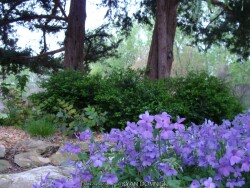



***Tree descriptions available with future update!***>>>>>In Eastern Kansas, this tree species performs WELL with just about everything nature has to challenge it! Extreme heat and drought are tolerated. Cold tolerance is no problem in our zone 6. No disease or pest problems. Great plant for berms, hot West or South exposures, and most any other garden situations in full sun. Will tolerate clay soils and extra moisture in summer. Fall color is variable in the Northern part of its range; sometimes an early frost wipes out the foliage before color can form. Interestingly, Chinese pistache is the only tree to develop fall color in the low deserts of the Southwest and as far South as Orlando, unaffected by heat and not dependant on cool night temperatures. In Stillwater, Oklahoma, chinese pistache would often hold color into December.
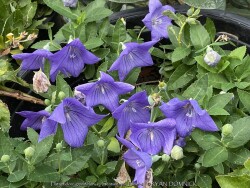

***Description for this perennial available with future update!***Dwarf Blue Balloonflower, is also known as Platycodon grandiflorus 'Sentimental Blue'
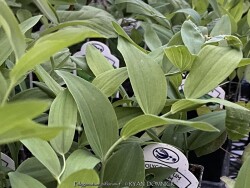

Solomon Seal (Polygonatum sp.) is a very large genus of perennials comprising dozens of species. Many of the species that are appropriate for garden use in Kansas are native to seasonally dry to moist forests in North America and Asia. New growth arises each year from a finger-like slowly spreading rhizome system. The foliage has a central stem with architecturally arranged opposite leaves covering the length of the stem gradually getting smaller towards the end. Small bell-shaped white flowers appear in early spring followed by bluish-purple fruit. Flowers and new spring growth is frost-hardy. Most Solomon seals do well with average garden soils and moisture with many tolerating dry-shade well. Solomon's seal can grow for many years increasing in density without ever needing division. Over time this creates a nearly weed-proof groundcover. in eastern Kansas with 40 inches of rain per year on average, there seems to be plenty of moisture to create extremely healthy patches of Solomon seal that compete well with tree roots. While some species can tolerate sun, there are many better choices as sunburning will likely occur with afternoon sun in temperatures over 95 degrees F. Combine with hostas or other shade plants to create a dramatic effect. Included in our "edibles" database but depends on how hungry you are! Polygonatum biflorum, also known as Smooth solomon's-seal, is native to Kansas and Central U.S. forests in average to moist conditions including dry-shade. It adds a bright splash of light green to the shade garden. Fruiting does occur and desirable self-seeding occurs within the patch. Plants reach heights of 18-24" tall in Kansas. Fall color is a brilliant yellow for a week before going dormant. Maintenance is easy as stems easily detach when raking with fall clean-up. If cosmetic foliage leaf-rust is a problem, just cut back early. During the April deep freeze of 2007, temperatures bottomed out at 18°F after an extra warm March. Hosta and Solomon seal foliage had completely unfurled and was flowering. All hostas were killed to the ground but solomon seal foliage and flowers survived un-damaged! A great "Once it's there, it's there forever" plant for dry-shade!
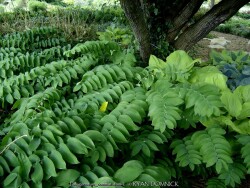

Solomon Seal (Polygonatum sp.) is a very large genus of perennials comprising dozens of species. Many of the species that are appropriate for garden use in Kansas are native to seasonally dry to moist forests in North America and Asia. New growth arises each year from a finger-like slowly spreading rhizome system. The foliage has a central stem with architecturally arranged opposite leaves covering the length of the stem gradually getting smaller towards the end. Small bell-shaped white flowers appear in early spring followed by bluish-purple fruit. Flowers and new spring growth is frost-hardy. Most Solomon seals do well with average garden soils and moisture with many tolerating dry-shade well. Solomon's seal can grow for many years increasing in density without ever needing division. Over time this creates a nearly weed-proof groundcover. in eastern Kansas with 40 inches of rain per year on average, there seems to be plenty of moisture to create extremely healthy patches of Solomon seal that compete well with tree roots. While some species can tolerate sun, there are many better choices as sunburning will likely occur with afternoon sun in temperatures over 95 degrees F. Combine with hostas or other shade plants to create a dramatic effect. Included in our "edibles" database but depends on how hungry you are! Polygonatum commutatum, also known as Great Solomon's seal, is native to Eastern U.S. forests in average to moist conditions. It adds a bright splash of light green to the shade garden. Fruiting does occur and desirable self-seeding occurs within the patch. Plants reach heights of 24-36" tall in Kansas. Fall color is a brilliant yellow for a week before going dormant. Maintenance is easy as stems easily detach when raking with fall clean-up. If cosmetic foliage leaf-rust is a problem, just cut back early. During the April deep freeze of 2007, temperatures bottomed out at 18°F after an extra warm March. Hosta and Solomon seal foliage had completely unfurled and was flowering. All hostas were killed to the ground but solomon seal foliage and flowers survived un-damaged! A great "Once it's there, it's there forever" plant for dry-shade!
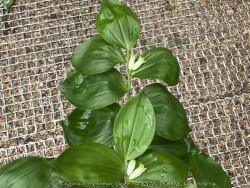

Solomon Seal (Polygonatum sp.) is a very large genus of perennials comprising dozens of species. Many of the species that are appropriate for garden use in Kansas are native to seasonally dry to moist forests in North America and Asia. New growth arises each year from a finger-like slowly spreading rhizome system. The foliage has a central stem with architecturally arranged opposite leaves covering the length of the stem gradually getting smaller towards the end. Small bell-shaped white flowers appear in early spring followed by bluish-purple fruit. Flowers and new spring growth is frost-hardy. Most Solomon seals do well with average garden soils and moisture with many tolerating dry-shade well. Solomon's seal can grow for many years increasing in density without ever needing division. Over time this creates a nearly weed-proof groundcover. in eastern Kansas with 40 inches of rain per year on average, there seems to be plenty of moisture to create extremely healthy patches of Solomon seal that compete well with tree roots. While some species can tolerate sun, there are many better choices as sunburning will likely occur with afternoon sun in temperatures over 95 degrees F. Combine with hostas or other shade plants to create a dramatic effect. Included in our "edibles" database but depends on how hungry you are! Hidden Flower Solomon's Seal (Polygonatum cryptanthum 'Crug') is one of the most attractive solomon seals in our display garden. This species forms a tight clump of slow-spreading rhizomes with bubbly, shiny green foliage 12" tall. Stems feature rows of small, white, clustered bells that do not open fully and are attached just below the leaf intersections. Brilliant blue fruit ripens late summer and fall. Fall color is a brilliant yellow for a week before going dormant. Maintenance is easy as stems easily detach when raking with fall clean-up. If cosmetic foliage leaf-rust is a problem, just cut back early. A great "Once it's there, it's there forever" plant for dry-shade! Rarely available for sale as propagation is slow.
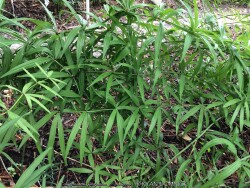

Solomon Seal (Polygonatum sp.) is a very large genus of perennials comprising dozens of species. Many of the species that are appropriate for garden use in Kansas are native to seasonally dry to moist forests in North America and Asia. Orange Flowering Climbing Solomon's Seal (Polygonatum kingianum / huanum) is definitely not typical of the genus! This plant has "climbed" above other Solomon seals! New vining growth several feet tall arises each year from a non-spreading rhizome. The foliage has a central stem with architecturally arranged opposite leaves covering the length of the stem gradually getting smaller towards the end. Two tiny hooks are located on the tips of each leaf, helping it to gently cling onto a structure or other plant for support. Elongated bell-shaped flowers appearing in spring are orange with green tips, yes ORANGE! This small "vine-like" plant is a curiosity and specimen plant. Grow in moist, well drained forest soil with average irrigation. This beauty can reach 12' tall but in our Kansas display garden, we are on year 3 (2021) with growth about 3' and increasing each year.
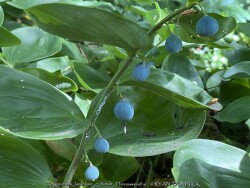

Solomon Seal (Polygonatum sp.) is a very large genus of perennials comprising dozens of species. Many of the species that are appropriate for garden use in Kansas are native to seasonally dry to moist forests in North America and Asia. New growth arises each year from a finger-like slowly spreading rhizome system. The foliage has a central stem with architecturally arranged opposite leaves covering the length of the stem gradually getting smaller towards the end. Small bell-shaped white flowers appear in early spring followed by bluish-purple fruit. Flowers and new spring growth is frost-hardy. Most Solomon seals do well with average garden soils and moisture with many tolerating dry-shade well. Solomon's seal can grow for many years increasing in density without ever needing division. Over time this creates a nearly weed-proof groundcover. in eastern Kansas with 40 inches of rain per year on average, there seems to be plenty of moisture to create extremely healthy patches of Solomon seal that compete well with tree roots. While some species can tolerate sun, there are many better choices as sunburning will likely occur with afternoon sun in temperatures over 95 degrees F. Combine with hostas or other shade plants to create a dramatic effect. Included in our "edibles" database but depends on how hungry you are! Wide-leaf Solomon's Seal (Polygonatum latifolium / hirtum 'Heronswood') is one of the most attractive solomon seals in our display garden. This species forms a tight clump of slow-spreading rhizomes with bubbly, shiny green foliage on stems 12" tall. Stems feature rows of small, white, clustered bells, attached just below the leaf intersections. Brilliant blue fruit ripens late summer and fall. Fall color is a brilliant yellow for a week before going dormant. Maintenance is easy as stems easily detach when raking with fall clean-up. If cosmetic foliage leaf-rust is a problem, just cut back early. A great "Once it's there, it's there forever" plant for dry-shade! Rarely available for sale as propagation is slow.
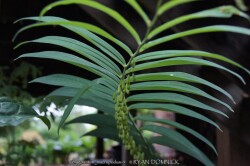

Solomon Seal (Polygonatum sp.) is a very large genus of perennials comprising dozens of species. Many of the species that are appropriate for garden use in Kansas are native to seasonally dry to moist forests in North America and Asia. New growth arises each year from a finger-like slowly spreading rhizome system. The foliage has a central stem with architecturally arranged opposite leaves covering the length of the stem gradually getting smaller towards the end. Small bell-shaped white flowers appear in early spring followed by bluish-purple fruit. Flowers and new spring growth is frost-hardy. Most Solomon seals do well with average garden soils and moisture with many tolerating dry-shade well. Solomon's seal can grow for many years increasing in density without ever needing division. Over time this creates a nearly weed-proof groundcover. in eastern Kansas with 40 inches of rain per year on average, there seems to be plenty of moisture to create extremely healthy patches of Solomon seal that compete well with tree roots. While some species can tolerate sun, there are many better choices as sunburning will likely occur with afternoon sun in temperatures over 95 degrees F. Combine with hostas or other shade plants to create a dramatic effect. Included in our "edibles" database but depends on how hungry you are! Big Footed Solomon's Seal (Polygonatum macropodum) is the largest and most architectural solomon seal in our display garden. This species forms a tight clump of slow-spreading rhizomes with symmetrical foliage upto 4' long. Stems feature long rows of small, white, clustered bells, attached just below the leaf intersections. Blue fruit ripens late summer and fall. Fall color is a brilliant yellow for a week before going dormant. Maintenance is easy as stems easily detach when raking with fall clean-up. If cosmetic foliage leaf-rust is a problem, just cut back early. During the April deep freeze of 2007, temperatures bottomed out at 18°F after an extra warm March. Hosta and Solomon seal foliage had completely unfurled and was flowering. All hostas were killed to the ground but solomon seal foliage and flowers survived un-damaged! A great "Once it's there, it's there forever" plant for dry-shade! Rarely available for sale as propagation is slow.
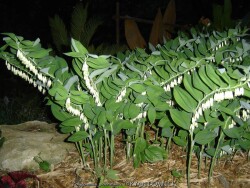

Solomon Seal (Polygonatum sp.) is a very large genus of perennials comprising dozens of species. Many of the species that are appropriate for garden use in Kansas are native to seasonally dry to moist forests in North America and Asia. New growth arises each year from a finger-like slowly spreading rhizome system. The foliage has a central stem with architecturally arranged opposite leaves covering the length of the stem gradually getting smaller towards the end. Small bell-shaped white flowers appear in early spring followed by bluish-purple fruit. Flowers and new spring growth is frost-hardy. Most Solomon seals do well with average garden soils and moisture with many tolerating dry-shade well. Solomon's seal can grow for many years increasing in density without ever needing division. Over time this creates a nearly weed-proof groundcover. in eastern Kansas with 40 inches of rain per year on average, there seems to be plenty of moisture to create extremely healthy patches of Solomon seal that compete well with tree roots. While some species can tolerate sun, there are many better choices as sunburning will likely occur with afternoon sun in temperatures over 95 degrees F. Combine with hostas or other shade plants to create a dramatic effect. Included in our "edibles" database but depends on how hungry you are! Medium Green Japanese Solomon's Seal (Polygonatum odoratum) adds a bright splash of light green to the shade garden. Fruiting does not occur on this variety like others. Height is uniformly 18-24" tall. Fall color is a brilliant yellow for a week before going dormant. Maintenance is easy as stems easily detach when raking with fall clean-up. If cosmetic foliage leaf-rust is a problem, just cut back early. During the April deep freeze of 2007, temperatures bottomed out at 18°F after an extra warm March. Hosta and Solomon seal foliage had completely unfurled and was flowering. All hostas were killed to the ground but solomon seal foliage and flowers survived un-damaged! A great "Once it's there, it's there forever" plant for dry-shade!


Solomon Seal (Polygonatum sp.) is a very large genus of perennials comprising dozens of species. Many of the species that are appropriate for garden use in Kansas are native to seasonally dry to moist forests in North America and Asia. New growth arises each year from a finger-like slowly spreading rhizome system. The foliage has a central stem with architecturally arranged opposite leaves covering the length of the stem gradually getting smaller towards the end. Small bell-shaped white flowers appear in early spring followed by bluish-purple fruit. Flowers and new spring growth is frost-hardy. Most Solomon seals do well with average garden soils and moisture with many tolerating dry-shade well. Solomon's seal can grow for many years increasing in density without ever needing division. Over time this creates a nearly weed-proof groundcover. in eastern Kansas with 40 inches of rain per year on average, there seems to be plenty of moisture to create extremely healthy patches of Solomon seal that compete well with tree roots. While some species can tolerate sun, there are many better choices as sunburning will likely occur with afternoon sun in temperatures over 95 degrees F. Combine with hostas or other shade plants to create a dramatic effect. Included in our "edibles" database but depends on how hungry you are! Ruby Slippers Solomon's Seal (Polygonatum odoratum 'Ruby Slippers') adds a bright splash of light green foliage and ruby-red stems to the shade garden. Height is uniformly 18-24" tall. Fall color is a brilliant yellow for a week before going dormant. Maintenance is easy as stems easily detach when raking with fall clean-up. A great "Once it's there, it's there forever" plant for dry-shade!
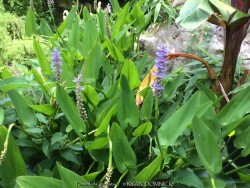

***Description for this water plant available with future update!***>>>>>This plant is usually grown as a bog plant needing constantly moist soil rich in organic matter. As a rain garden plant, it will thrive is a depressed area in the landscape that collects rain water from a roof during spring and summer periods of rain but then go dormant if the water hole dries out completely. For the home garden, the species is generally too aggressive to mix with other plants
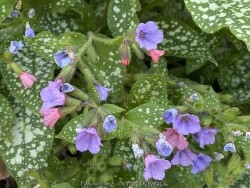

Lungwort (Pulmonoria saccharata) is planted for its unusual evergreen spekled white and green foliage. Foliage maintains well all summer provided that basic cultural conditions are met. Late spring flowers are a bright and colorful mix of blue, purple, and pink on the same plant changing colors as they age. Flowering last about 3-4 weeks and requires no dead-heading as new foliage swallows up dying flower stalks. Native to Europe, it slowly colonizes forests in humusy, medium well-drained soil in part shade to full shade. It can handle a little Kansas drought in in moisture-retentive soils but not full-on dry-shade. Foliage will flatten to the ground during drought then spring back up when moisture is available again. If low temperatures hit 0 degrees F, foliage finally dies back to the ground and re-emerges in early spring. Generally this plant holds its own in Kansas climates but fails to spread much. Leaves can depreciate considerably in extremely hot weather and/or too much sun, particularly if soils are allowed to dry out. Root rot may occur in wet, poorly drained soils. It is worth a try if you have a small spot to fill in a well-tended shade gardens.


Blackberry (Rubus sp.) is an "easy to grow" edible fruit that is worth growing in Kansas. Store-bought blackberries are expensive and don't taste as good as garden grown fruits. All cultivars of blackberries have perennial roots, but most top shoots only live for two years. (meaning shoots grow in the first growing season and fruits grow on those shoots during the second growing season) The cycle is repeated; maintenance involves removing old canes after decline or death. Raspberries are vigorous and can be locally invasive in the garden but rarely invasive in the wild. They propagate by basal shoots (also known as suckers) spreading some distance from the main plant. After establishment, it is high maintenance if it has already filled the space and you don't want it to spread any further so plan accordingly. In the landscape, raspberry and blackberry mix well into garden designs with ornamental plants as long as you create it's own area (like a background fence to train plants on) The main difference between raspberry and blackberry are that the fruit releases from the raspberry differently. The "torus" or inside center of the fruit is hollow and releases from the stem with raspberry. With Blackberry, the "torus" or center "picks with" the fruit giving a solid fruit to eat. (just in case you have always wondered) Our supplier, Spring Meadows Nursery has this to say about this new PROVEN WINNERS plant: Taste of Heaven blackberry (Rubus 'Ponca') is the sweetest, most flavorful blackberry on the market - and now you can grow it at home. We know, that's a tall claim, but you don't need to take our word for it: this article in the journal HortScience confirms it. And we know because we tasted literally hundreds of different blackberry varieties before deciding this would be the one to make it on to further testing. Taste of Heaven is a vigorous, thornless blackberry that produces large, luscious fruits over several weeks in summer. It's a floricane variety, fruiting only on second-year canes, and does not strictly require trellising or support, though in the garden, it is easier to care for and harvest with something in place.
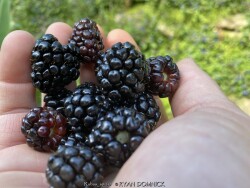

Blackberry (Rubus sp.) is an "easy to grow" edible fruit that is worth growing in Kansas. Store-bought blackberries are expensive and don't taste as good as garden grown fruits. All cultivars of blackberries have perennial roots, but most top shoots only live for two years. (meaning shoots grow in the first growing season and fruits grow on those shoots during the second growing season) The cycle is repeated; maintenance involves removing old canes after decline or death. Raspberries are vigorous and can be locally invasive in the garden but rarely invasive in the wild. They propagate by basal shoots (also known as suckers) spreading some distance from the main plant. After establishment, it is high maintenance if it has already filled the space and you don't want it to spread any further so plan accordingly. In the landscape, raspberry and blackberry mix well into garden designs with ornamental plants as long as you create it's own area (like a background fence to train plants on) The main difference between raspberry and blackberry are that the fruit releases from the raspberry differently. The "torus" or inside center of the fruit is hollow and releases from the stem with raspberry. With Blackberry, the "torus" or center "picks with" the fruit giving a solid fruit to eat. (just in case you have always wondered) Our supplier, Forrest Keeling nursery, has released an array of improved hybrids and varieties available.
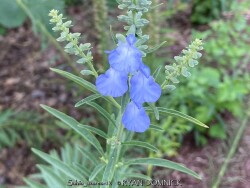

***Description for this plant available with future update!***


***Description for this plant available with future update!***


***Description for this plant available with future update!***
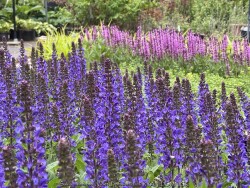

***Description for this perennial available with future update!***>>>>>Enjoy these flowers again and again throughout the summer with rebloom! Violet blue flowers are produced on rosy purple calyxes on a perfectly rounded, dense and beautiful habit.>>>>>>>>>All Proven Winners® plants are legally propagated, healthy and vigorous, true to name, and tagged with color pictures and growing information.
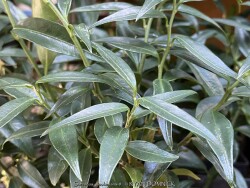

Himalayan Sweet Box (Sarcococca hookeriana) is planted for its evergreen dark green foliage and white flowers. Foliage maintains well all year provided that certain cultural conditions are met. Native to shaded mountain areas in forests, valleys or along streams in the Himalayas, it needs moist soil rich in organic matter avoiding too much clay. It is somewhat drought tolerant once established. If low temperatures hit -5 to -10 degrees F, foliage finally dies back to the ground and re-emerges in early spring. Generally this plant can decline after a few years of Kansas climate but is worth a try in perfect soils in well-tended shade gardens. If low temperatures hit -10 degrees F, it may kill an un-mulched plant; protect any zone 6 plant with thick layer of mulch. Lack of moisture and competition with weeds seem to be an issue but it survives just fine. Growth is extremely slow. This is one of the most deep shade tolerant plants available.
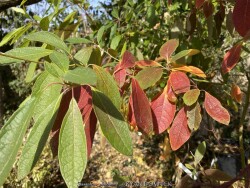

***Tree descriptions available with future update!***Sassafras Tree, is also known as Sassafras albidum
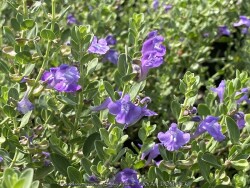

***Description for this perennial available with future update!***Smoky Hills Skullcap / Native Scutellaria, is also known as Scutellaria resinosa 'Smoky Hills'
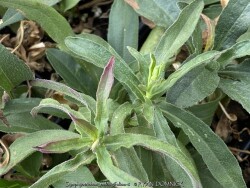

***Description for this perennial available with future update!***
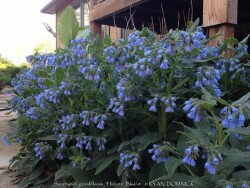

Dry Shade Comfrey / Large-Flowered Comfrey (Symphytum grandiflorum) is a perennial native to Europe with textured sandpapery green leaves and light yellow flowers. It spreads by creeping rhizomes and forms an attractive groundcover. Foliage is quite dense forming a tight weed resistant covering. Comfrey prefers rich average to moist well-drained soils with part sun to full shade. However, being a tolerant plant, is very adaptable to both dry and moist locations and will grow quite nicely in dry shade. It is not particular as to soil type or pH. and is highly tolerant of urban pollution and will even thrive in inner city environments. There is virtually no maintenance unless you want to mow down the dead foliage in the winter. It is also suggested to deadhead the flowers after blooming as they are not attractive. But if you don't, they will die back on their own and get swallowed up by the foliage. In addition to being a great perennial for your landscape, this comfrey may have herbal uses as well. There are no pest, disease, or browser problems. Considered one of the best plants for solving your most difficult dry-shade landscape challenges. The blue variety, Symphytum grandiflorum 'Hidcote Blue', has more of a blue green foliage and light blue flowers on taller flower spikes. Spread is also more rapid and sometimes to the point of aggressive and rich moist soil. Comfrey is a great underused plant worthy of more wide scale use in the landscape. Dry Shade Comfrey has persisted through over a decade in our Lawrence, KS display garden with no problems.
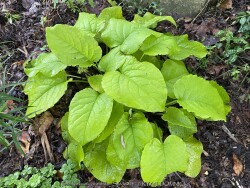

Sundew Oriental Borage / Black Sea Comfrey (Trachystemon orientalis 'Sundew') is a perennial with large textured bright chartreuse leaves with amazing contrasting light blue flowers. It is native from Bulgaria to the Caucasus and Turkey. This variety spreads very slowly by creeping rhizomes and forms an attractive groundcover. Foliage darkens slightly to green in summer and forms a quite dense and tight weed resistant covering. Comfrey prefers rich average to moist well-drained soils with part sun to full shade. However, being a tolerant plant, is very adaptable to both dry and moist locations and will grow quite nicely in dry shade. It is not particular as to soil type or pH. and is highly tolerant of urban pollution and will even thrive in inner city environments. There is virtually no maintenance unless you want to mow down the dead foliage in the winter. It is also suggested to deadhead the flowers after blooming as they are not attractive. But if you don't, they will die back on their own and get swallowed up by the foliage. There are no pest, disease, or browser problems. Considered one of the best plants for solving your most difficult dry-shade landscape challenges. Trachystemon orientalis 'Sundew' has persisted through over a decade in our Lawrence, KS display garden with no problems. Our original display garden plant came from Plant Delights Nursery in North Carolina.
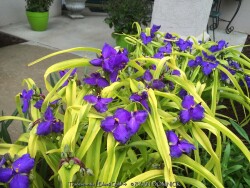

***Description for this perennial available with future update!***Blue & Gold Spiderwort, is also known as Tradescantia x andersoniana 'Blue and Gold'


Sky Dew Gold ornamental blueberry has such appealing bright gold foliage that the flowers and berries are almost an afterthought. Its display gets even more interesting as the summer nights start to cool, and the golden foliage starts taking on rich hues of orange and red. The effect is simply thrilling; seeing something so colorful and cheerful puts a smile on your face. Highbush Blueberry, (Vaccinium corymbosum) needs rich organic acidic soil. You can easily create this by adding a mound of ground up leaves from your fall cleanup each year.
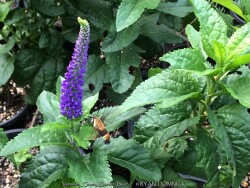

***Description for this perennial available with future update!***Sunny Border Blue Veronica, is also known as Veronica 'Sunny Border Blue'
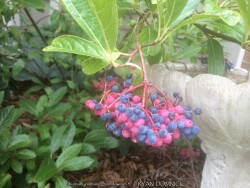

***Shrub descriptions available with future update!***
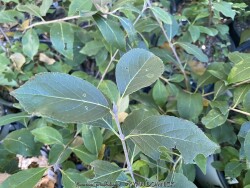

***Shrub descriptions available with future update!***Blackhaw Native Viburnum, is also known as Viburnum prunifolium
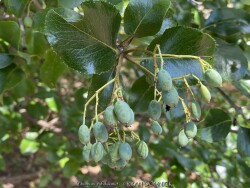

***Shrub descriptions available with future update!***Rusty Blackhaw Native Viburnum, is also known as Viburnum rufidulum
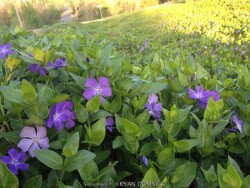

***Description for this perennial available with future update!***Vinca Major / Periwinkle, is also known as Vinca major
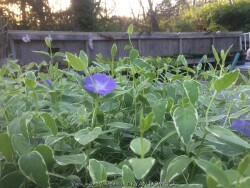

***Description for this perennial available with future update!***Variegated Vinca Major, is also known as Vinca major 'Variegata'
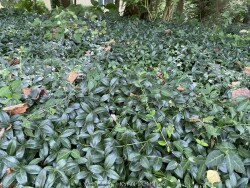

Vinca Minor / Periwinkle is an evergreen groundcover native to central and southern Europe but naturalized and has become invasive in parts of North America. The evergreen leaves are a glossy dark green with a leathery texture. The 5-petal violet-purple flowers are produced mainly from early spring to mid summer but with a few flowers still produced into the autumn. Landscape uses include small scale groundcovers and hillside areas in full to part shade. In full sun, foliage burn occurs in late summer and with slow recovery, weeds find an opportunity to invade. Due to slow spreading growth in our Kansas climate, you shouldn't leave very much room in-between vinca plants or you will be waiting many years for the patch to fill in. Weeds can again be a problem in that open area between plants if spacing is too wide. We recommend 9-12" spacing and use for small nooks in the shade garden. If planning for a larger area, still figure on the tight spacing but allow for a higher budget that you will consider a permanent investment. However, a serious vine stem canker (blight / disease), limits its use in our area and can damage or kill large patches. Good air circulation and limiting night-time irrigation can reduce the prevalence of this disease. Generally this plant declines after a few years of Kansas climate but worth a try in perfect soils in well-tended shade gardens. The canker disease and competition with weeds seem to be an issue. Roundup effectively eraticates patchy leftover remnant growth after disease runs its course when clearing the area for better groundcover species.